Cost Accounting Report: Analysis of Costs and Revenues for M&S
VerifiedAdded on 2020/10/22
|20
|3755
|313
Report
AI Summary
This report provides a detailed analysis of costs and revenues, focusing on Marks and Spencer. It covers internal reporting, costing systems (historical, direct, absorption, and marginal), and cost classifications (fixed, variable, semi-variable). The report presents a cost sheet and analyzes cost information, including raw materials, direct labor, and overheads. It discusses inventory valuation methods (FIFO, batch, unit, process, and service costing) and cost behaviors. Furthermore, the report addresses overhead allocation and apportionment, calculating overhead absorption rates, and calculating over and under absorption of labor and wages. It also compares budgeted and actual costs, analyzes variances, and prepares a management report. Finally, the report examines the effects of changes in activity levels on unit costs and identifies factors affecting short and long-term decision-making.
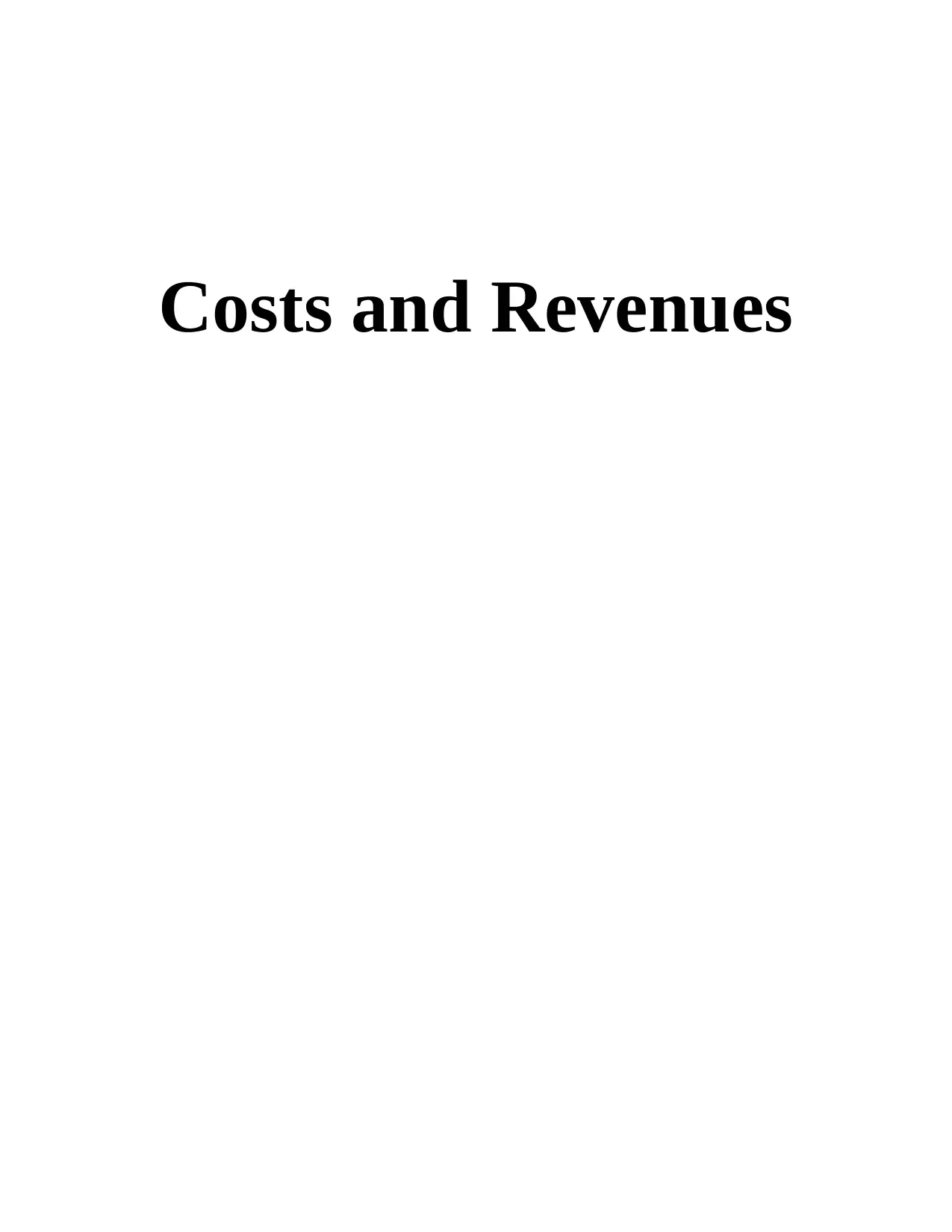
Costs and Revenues
Paraphrase This Document
Need a fresh take? Get an instant paraphrase of this document with our AI Paraphraser
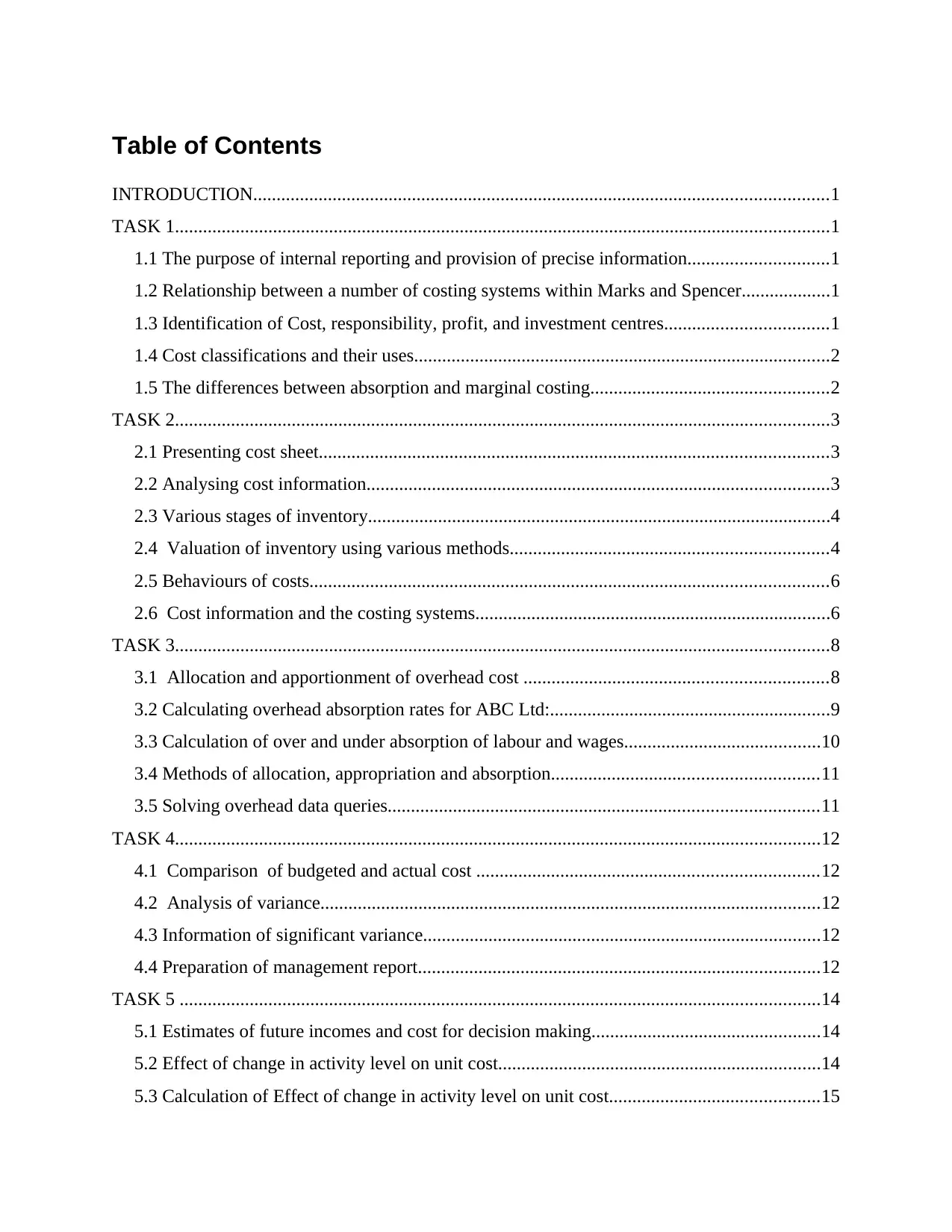
Table of Contents
INTRODUCTION...........................................................................................................................1
TASK 1............................................................................................................................................1
1.1 The purpose of internal reporting and provision of precise information..............................1
1.2 Relationship between a number of costing systems within Marks and Spencer...................1
1.3 Identification of Cost, responsibility, profit, and investment centres...................................1
1.4 Cost classifications and their uses.........................................................................................2
1.5 The differences between absorption and marginal costing...................................................2
TASK 2............................................................................................................................................3
2.1 Presenting cost sheet.............................................................................................................3
2.2 Analysing cost information...................................................................................................3
2.3 Various stages of inventory...................................................................................................4
2.4 Valuation of inventory using various methods....................................................................4
2.5 Behaviours of costs...............................................................................................................6
2.6 Cost information and the costing systems............................................................................6
TASK 3............................................................................................................................................8
3.1 Allocation and apportionment of overhead cost .................................................................8
3.2 Calculating overhead absorption rates for ABC Ltd:............................................................9
3.3 Calculation of over and under absorption of labour and wages..........................................10
3.4 Methods of allocation, appropriation and absorption.........................................................11
3.5 Solving overhead data queries............................................................................................11
TASK 4..........................................................................................................................................12
4.1 Comparison of budgeted and actual cost .........................................................................12
4.2 Analysis of variance...........................................................................................................12
4.3 Information of significant variance.....................................................................................12
4.4 Preparation of management report......................................................................................12
TASK 5 .........................................................................................................................................14
5.1 Estimates of future incomes and cost for decision making.................................................14
5.2 Effect of change in activity level on unit cost.....................................................................14
5.3 Calculation of Effect of change in activity level on unit cost.............................................15
INTRODUCTION...........................................................................................................................1
TASK 1............................................................................................................................................1
1.1 The purpose of internal reporting and provision of precise information..............................1
1.2 Relationship between a number of costing systems within Marks and Spencer...................1
1.3 Identification of Cost, responsibility, profit, and investment centres...................................1
1.4 Cost classifications and their uses.........................................................................................2
1.5 The differences between absorption and marginal costing...................................................2
TASK 2............................................................................................................................................3
2.1 Presenting cost sheet.............................................................................................................3
2.2 Analysing cost information...................................................................................................3
2.3 Various stages of inventory...................................................................................................4
2.4 Valuation of inventory using various methods....................................................................4
2.5 Behaviours of costs...............................................................................................................6
2.6 Cost information and the costing systems............................................................................6
TASK 3............................................................................................................................................8
3.1 Allocation and apportionment of overhead cost .................................................................8
3.2 Calculating overhead absorption rates for ABC Ltd:............................................................9
3.3 Calculation of over and under absorption of labour and wages..........................................10
3.4 Methods of allocation, appropriation and absorption.........................................................11
3.5 Solving overhead data queries............................................................................................11
TASK 4..........................................................................................................................................12
4.1 Comparison of budgeted and actual cost .........................................................................12
4.2 Analysis of variance...........................................................................................................12
4.3 Information of significant variance.....................................................................................12
4.4 Preparation of management report......................................................................................12
TASK 5 .........................................................................................................................................14
5.1 Estimates of future incomes and cost for decision making.................................................14
5.2 Effect of change in activity level on unit cost.....................................................................14
5.3 Calculation of Effect of change in activity level on unit cost.............................................15
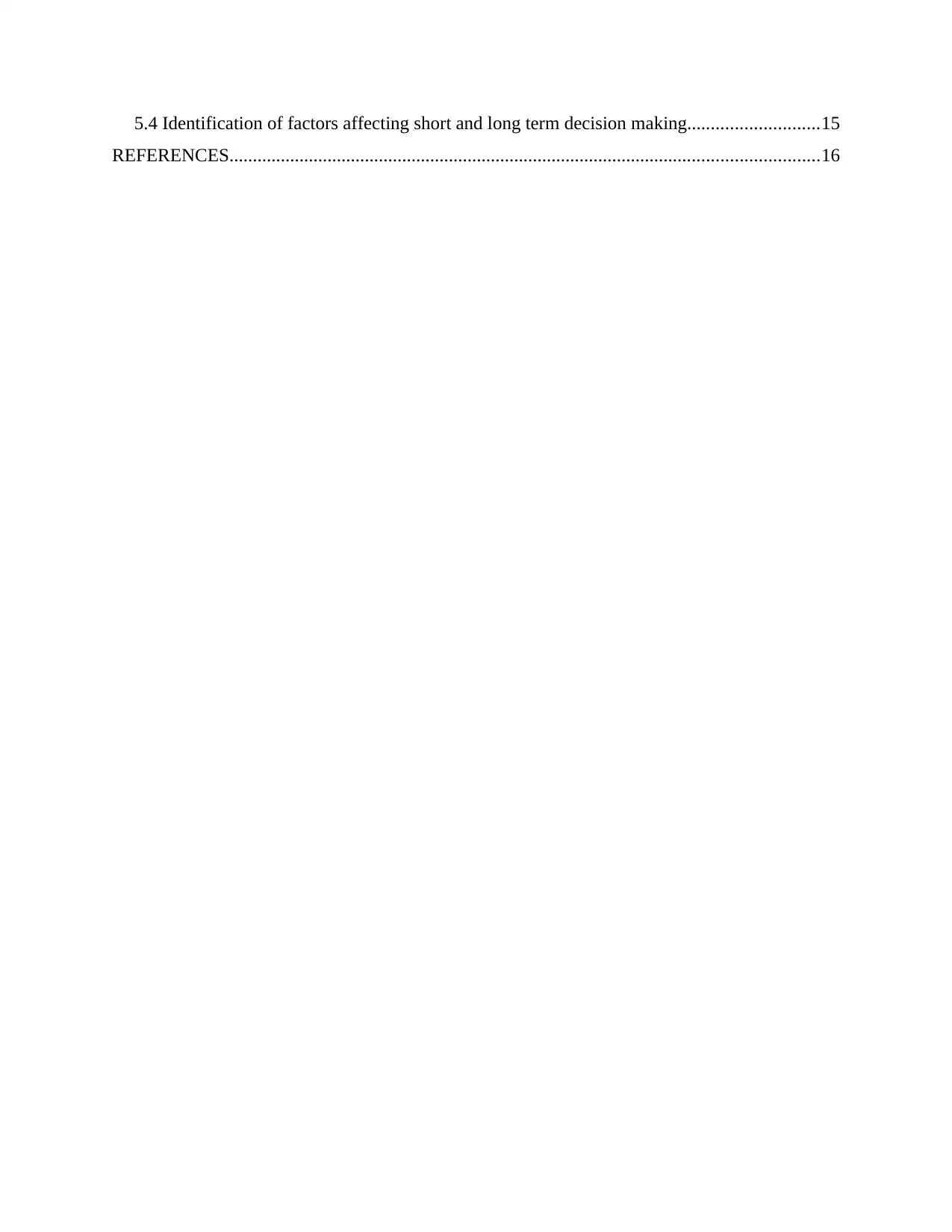
5.4 Identification of factors affecting short and long term decision making............................15
REFERENCES..............................................................................................................................16
REFERENCES..............................................................................................................................16
⊘ This is a preview!⊘
Do you want full access?
Subscribe today to unlock all pages.

Trusted by 1+ million students worldwide
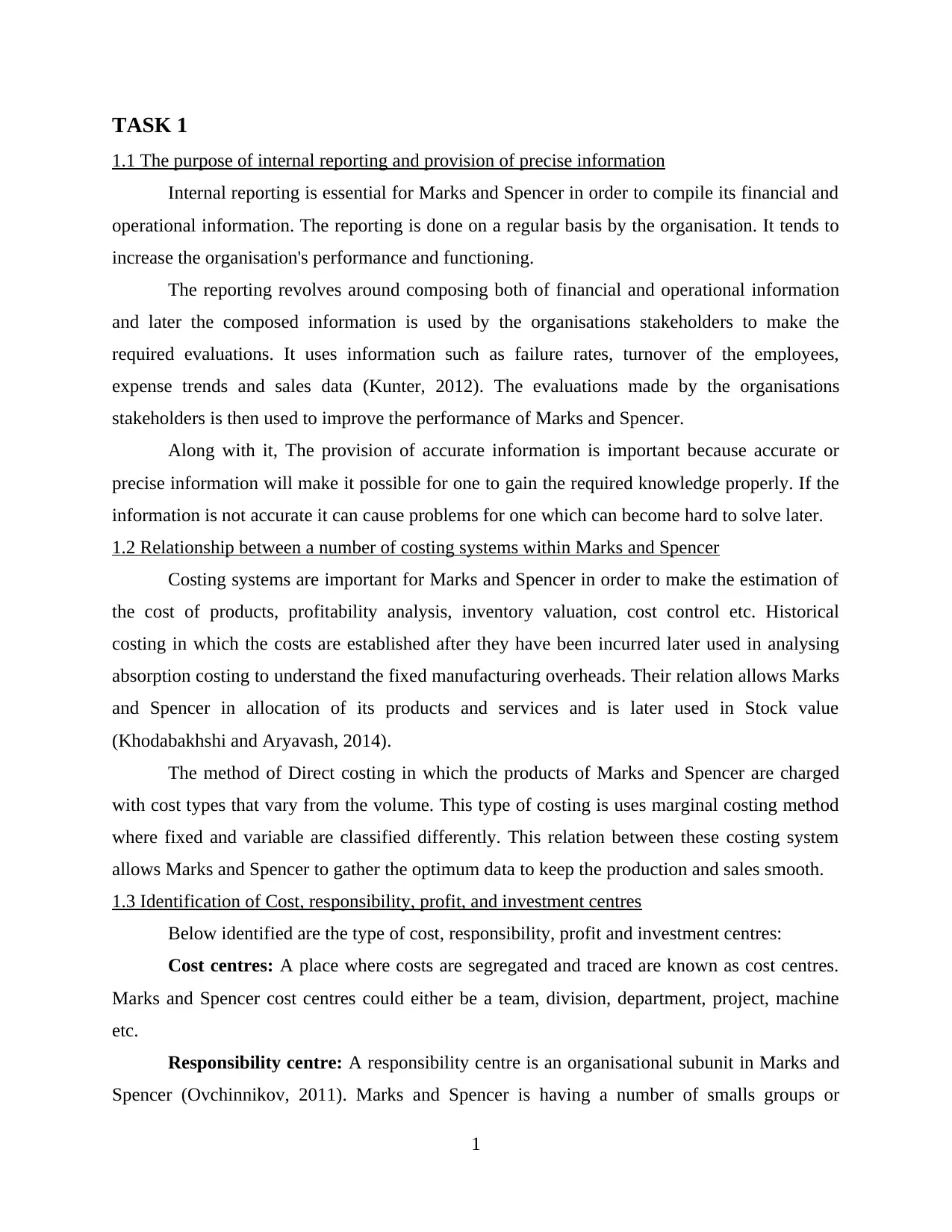
TASK 1
1.1 The purpose of internal reporting and provision of precise information
Internal reporting is essential for Marks and Spencer in order to compile its financial and
operational information. The reporting is done on a regular basis by the organisation. It tends to
increase the organisation's performance and functioning.
The reporting revolves around composing both of financial and operational information
and later the composed information is used by the organisations stakeholders to make the
required evaluations. It uses information such as failure rates, turnover of the employees,
expense trends and sales data (Kunter, 2012). The evaluations made by the organisations
stakeholders is then used to improve the performance of Marks and Spencer.
Along with it, The provision of accurate information is important because accurate or
precise information will make it possible for one to gain the required knowledge properly. If the
information is not accurate it can cause problems for one which can become hard to solve later.
1.2 Relationship between a number of costing systems within Marks and Spencer
Costing systems are important for Marks and Spencer in order to make the estimation of
the cost of products, profitability analysis, inventory valuation, cost control etc. Historical
costing in which the costs are established after they have been incurred later used in analysing
absorption costing to understand the fixed manufacturing overheads. Their relation allows Marks
and Spencer in allocation of its products and services and is later used in Stock value
(Khodabakhshi and Aryavash, 2014).
The method of Direct costing in which the products of Marks and Spencer are charged
with cost types that vary from the volume. This type of costing is uses marginal costing method
where fixed and variable are classified differently. This relation between these costing system
allows Marks and Spencer to gather the optimum data to keep the production and sales smooth.
1.3 Identification of Cost, responsibility, profit, and investment centres
Below identified are the type of cost, responsibility, profit and investment centres:
Cost centres: A place where costs are segregated and traced are known as cost centres.
Marks and Spencer cost centres could either be a team, division, department, project, machine
etc.
Responsibility centre: A responsibility centre is an organisational subunit in Marks and
Spencer (Ovchinnikov, 2011). Marks and Spencer is having a number of smalls groups or
1
1.1 The purpose of internal reporting and provision of precise information
Internal reporting is essential for Marks and Spencer in order to compile its financial and
operational information. The reporting is done on a regular basis by the organisation. It tends to
increase the organisation's performance and functioning.
The reporting revolves around composing both of financial and operational information
and later the composed information is used by the organisations stakeholders to make the
required evaluations. It uses information such as failure rates, turnover of the employees,
expense trends and sales data (Kunter, 2012). The evaluations made by the organisations
stakeholders is then used to improve the performance of Marks and Spencer.
Along with it, The provision of accurate information is important because accurate or
precise information will make it possible for one to gain the required knowledge properly. If the
information is not accurate it can cause problems for one which can become hard to solve later.
1.2 Relationship between a number of costing systems within Marks and Spencer
Costing systems are important for Marks and Spencer in order to make the estimation of
the cost of products, profitability analysis, inventory valuation, cost control etc. Historical
costing in which the costs are established after they have been incurred later used in analysing
absorption costing to understand the fixed manufacturing overheads. Their relation allows Marks
and Spencer in allocation of its products and services and is later used in Stock value
(Khodabakhshi and Aryavash, 2014).
The method of Direct costing in which the products of Marks and Spencer are charged
with cost types that vary from the volume. This type of costing is uses marginal costing method
where fixed and variable are classified differently. This relation between these costing system
allows Marks and Spencer to gather the optimum data to keep the production and sales smooth.
1.3 Identification of Cost, responsibility, profit, and investment centres
Below identified are the type of cost, responsibility, profit and investment centres:
Cost centres: A place where costs are segregated and traced are known as cost centres.
Marks and Spencer cost centres could either be a team, division, department, project, machine
etc.
Responsibility centre: A responsibility centre is an organisational subunit in Marks and
Spencer (Ovchinnikov, 2011). Marks and Spencer is having a number of smalls groups or
1
Paraphrase This Document
Need a fresh take? Get an instant paraphrase of this document with our AI Paraphraser
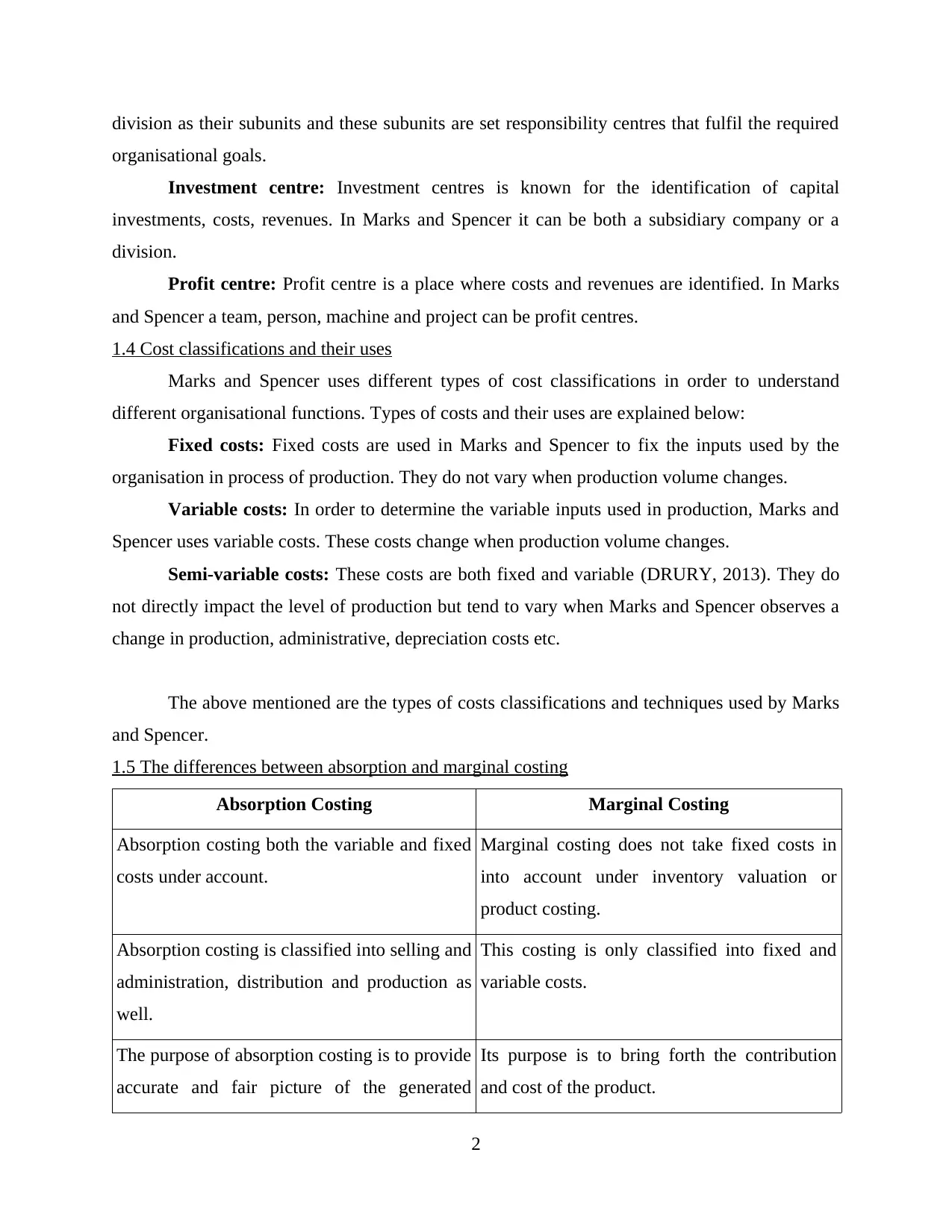
division as their subunits and these subunits are set responsibility centres that fulfil the required
organisational goals.
Investment centre: Investment centres is known for the identification of capital
investments, costs, revenues. In Marks and Spencer it can be both a subsidiary company or a
division.
Profit centre: Profit centre is a place where costs and revenues are identified. In Marks
and Spencer a team, person, machine and project can be profit centres.
1.4 Cost classifications and their uses
Marks and Spencer uses different types of cost classifications in order to understand
different organisational functions. Types of costs and their uses are explained below:
Fixed costs: Fixed costs are used in Marks and Spencer to fix the inputs used by the
organisation in process of production. They do not vary when production volume changes.
Variable costs: In order to determine the variable inputs used in production, Marks and
Spencer uses variable costs. These costs change when production volume changes.
Semi-variable costs: These costs are both fixed and variable (DRURY, 2013). They do
not directly impact the level of production but tend to vary when Marks and Spencer observes a
change in production, administrative, depreciation costs etc.
The above mentioned are the types of costs classifications and techniques used by Marks
and Spencer.
1.5 The differences between absorption and marginal costing
Absorption Costing Marginal Costing
Absorption costing both the variable and fixed
costs under account.
Marginal costing does not take fixed costs in
into account under inventory valuation or
product costing.
Absorption costing is classified into selling and
administration, distribution and production as
well.
This costing is only classified into fixed and
variable costs.
The purpose of absorption costing is to provide
accurate and fair picture of the generated
Its purpose is to bring forth the contribution
and cost of the product.
2
organisational goals.
Investment centre: Investment centres is known for the identification of capital
investments, costs, revenues. In Marks and Spencer it can be both a subsidiary company or a
division.
Profit centre: Profit centre is a place where costs and revenues are identified. In Marks
and Spencer a team, person, machine and project can be profit centres.
1.4 Cost classifications and their uses
Marks and Spencer uses different types of cost classifications in order to understand
different organisational functions. Types of costs and their uses are explained below:
Fixed costs: Fixed costs are used in Marks and Spencer to fix the inputs used by the
organisation in process of production. They do not vary when production volume changes.
Variable costs: In order to determine the variable inputs used in production, Marks and
Spencer uses variable costs. These costs change when production volume changes.
Semi-variable costs: These costs are both fixed and variable (DRURY, 2013). They do
not directly impact the level of production but tend to vary when Marks and Spencer observes a
change in production, administrative, depreciation costs etc.
The above mentioned are the types of costs classifications and techniques used by Marks
and Spencer.
1.5 The differences between absorption and marginal costing
Absorption Costing Marginal Costing
Absorption costing both the variable and fixed
costs under account.
Marginal costing does not take fixed costs in
into account under inventory valuation or
product costing.
Absorption costing is classified into selling and
administration, distribution and production as
well.
This costing is only classified into fixed and
variable costs.
The purpose of absorption costing is to provide
accurate and fair picture of the generated
Its purpose is to bring forth the contribution
and cost of the product.
2
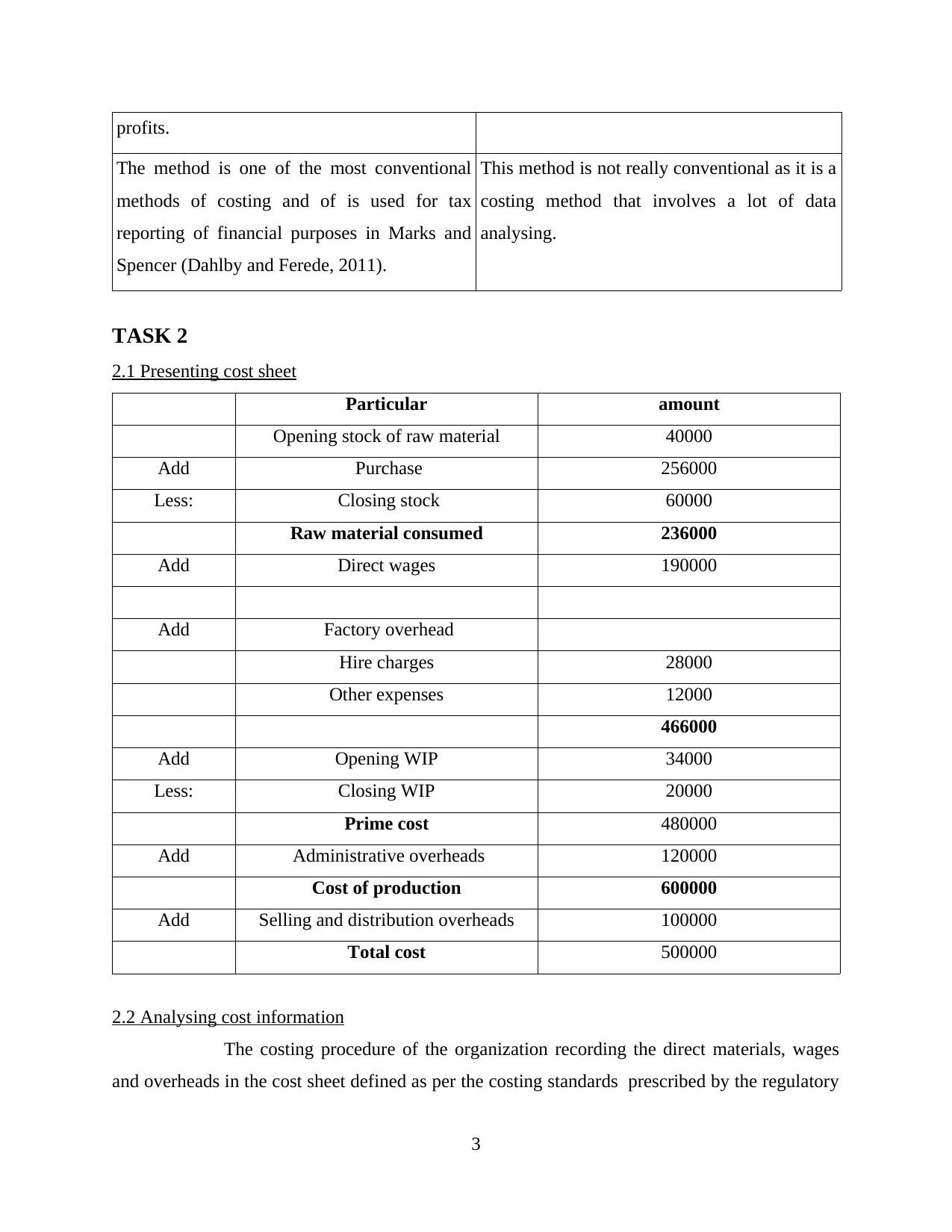
profits.
The method is one of the most conventional
methods of costing and of is used for tax
reporting of financial purposes in Marks and
Spencer (Dahlby and Ferede, 2011).
This method is not really conventional as it is a
costing method that involves a lot of data
analysing.
TASK 2
2.1 Presenting cost sheet
Particular amount
Opening stock of raw material 40000
Add Purchase 256000
Less: Closing stock 60000
Raw material consumed 236000
Add Direct wages 190000
Add Factory overhead
Hire charges 28000
Other expenses 12000
466000
Add Opening WIP 34000
Less: Closing WIP 20000
Prime cost 480000
Add Administrative overheads 120000
Cost of production 600000
Add Selling and distribution overheads 100000
Total cost 500000
2.2 Analysing cost information
The costing procedure of the organization recording the direct materials, wages
and overheads in the cost sheet defined as per the costing standards prescribed by the regulatory
3
The method is one of the most conventional
methods of costing and of is used for tax
reporting of financial purposes in Marks and
Spencer (Dahlby and Ferede, 2011).
This method is not really conventional as it is a
costing method that involves a lot of data
analysing.
TASK 2
2.1 Presenting cost sheet
Particular amount
Opening stock of raw material 40000
Add Purchase 256000
Less: Closing stock 60000
Raw material consumed 236000
Add Direct wages 190000
Add Factory overhead
Hire charges 28000
Other expenses 12000
466000
Add Opening WIP 34000
Less: Closing WIP 20000
Prime cost 480000
Add Administrative overheads 120000
Cost of production 600000
Add Selling and distribution overheads 100000
Total cost 500000
2.2 Analysing cost information
The costing procedure of the organization recording the direct materials, wages
and overheads in the cost sheet defined as per the costing standards prescribed by the regulatory
3
⊘ This is a preview!⊘
Do you want full access?
Subscribe today to unlock all pages.

Trusted by 1+ million students worldwide
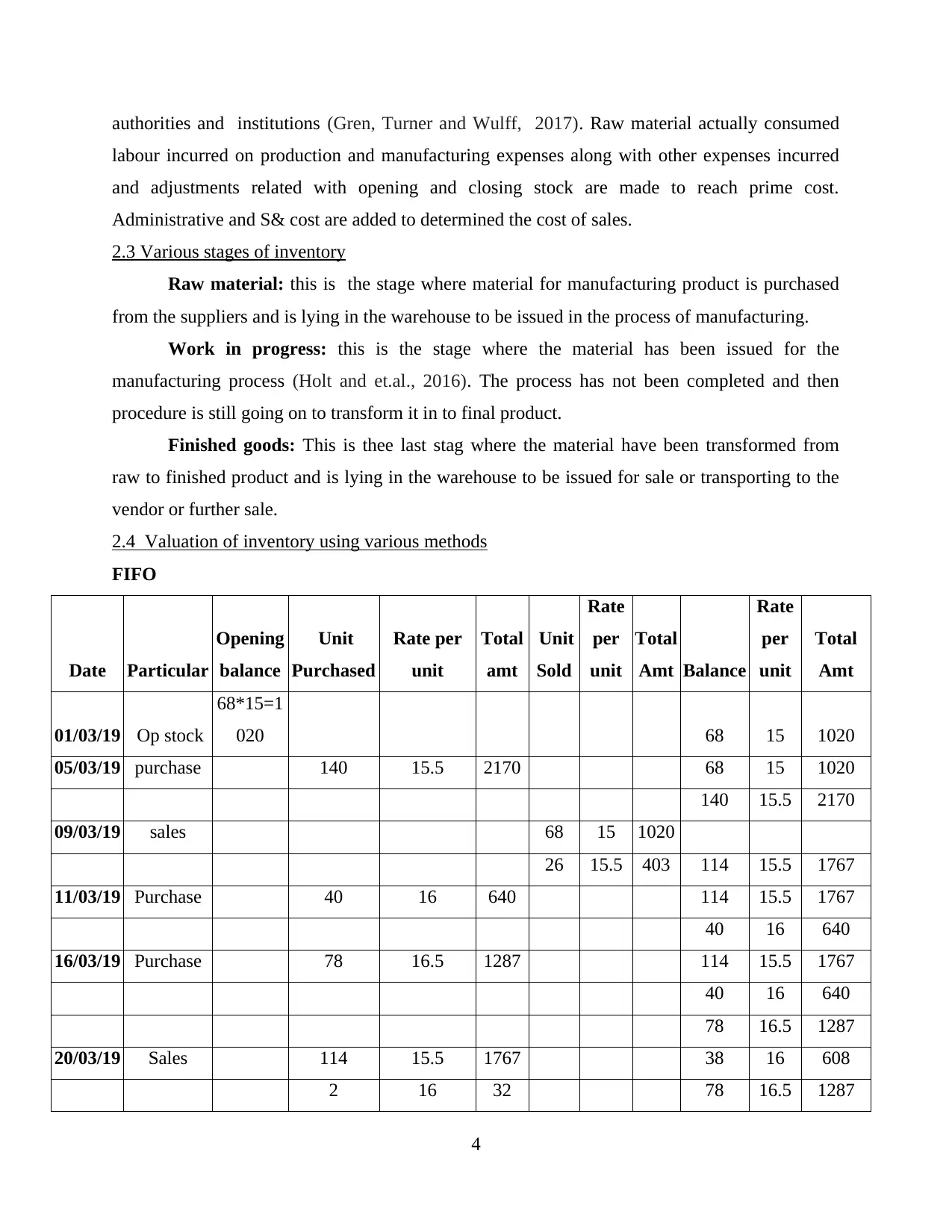
authorities and institutions (Gren, Turner and Wulff, 2017). Raw material actually consumed
labour incurred on production and manufacturing expenses along with other expenses incurred
and adjustments related with opening and closing stock are made to reach prime cost.
Administrative and S& cost are added to determined the cost of sales.
2.3 Various stages of inventory
Raw material: this is the stage where material for manufacturing product is purchased
from the suppliers and is lying in the warehouse to be issued in the process of manufacturing.
Work in progress: this is the stage where the material has been issued for the
manufacturing process (Holt and et.al., 2016). The process has not been completed and then
procedure is still going on to transform it in to final product.
Finished goods: This is thee last stag where the material have been transformed from
raw to finished product and is lying in the warehouse to be issued for sale or transporting to the
vendor or further sale.
2.4 Valuation of inventory using various methods
FIFO
Date Particular
Opening
balance
Unit
Purchased
Rate per
unit
Total
amt
Unit
Sold
Rate
per
unit
Total
Amt Balance
Rate
per
unit
Total
Amt
01/03/19 Op stock
68*15=1
020 68 15 1020
05/03/19 purchase 140 15.5 2170 68 15 1020
140 15.5 2170
09/03/19 sales 68 15 1020
26 15.5 403 114 15.5 1767
11/03/19 Purchase 40 16 640 114 15.5 1767
40 16 640
16/03/19 Purchase 78 16.5 1287 114 15.5 1767
40 16 640
78 16.5 1287
20/03/19 Sales 114 15.5 1767 38 16 608
2 16 32 78 16.5 1287
4
labour incurred on production and manufacturing expenses along with other expenses incurred
and adjustments related with opening and closing stock are made to reach prime cost.
Administrative and S& cost are added to determined the cost of sales.
2.3 Various stages of inventory
Raw material: this is the stage where material for manufacturing product is purchased
from the suppliers and is lying in the warehouse to be issued in the process of manufacturing.
Work in progress: this is the stage where the material has been issued for the
manufacturing process (Holt and et.al., 2016). The process has not been completed and then
procedure is still going on to transform it in to final product.
Finished goods: This is thee last stag where the material have been transformed from
raw to finished product and is lying in the warehouse to be issued for sale or transporting to the
vendor or further sale.
2.4 Valuation of inventory using various methods
FIFO
Date Particular
Opening
balance
Unit
Purchased
Rate per
unit
Total
amt
Unit
Sold
Rate
per
unit
Total
Amt Balance
Rate
per
unit
Total
Amt
01/03/19 Op stock
68*15=1
020 68 15 1020
05/03/19 purchase 140 15.5 2170 68 15 1020
140 15.5 2170
09/03/19 sales 68 15 1020
26 15.5 403 114 15.5 1767
11/03/19 Purchase 40 16 640 114 15.5 1767
40 16 640
16/03/19 Purchase 78 16.5 1287 114 15.5 1767
40 16 640
78 16.5 1287
20/03/19 Sales 114 15.5 1767 38 16 608
2 16 32 78 16.5 1287
4
Paraphrase This Document
Need a fresh take? Get an instant paraphrase of this document with our AI Paraphraser
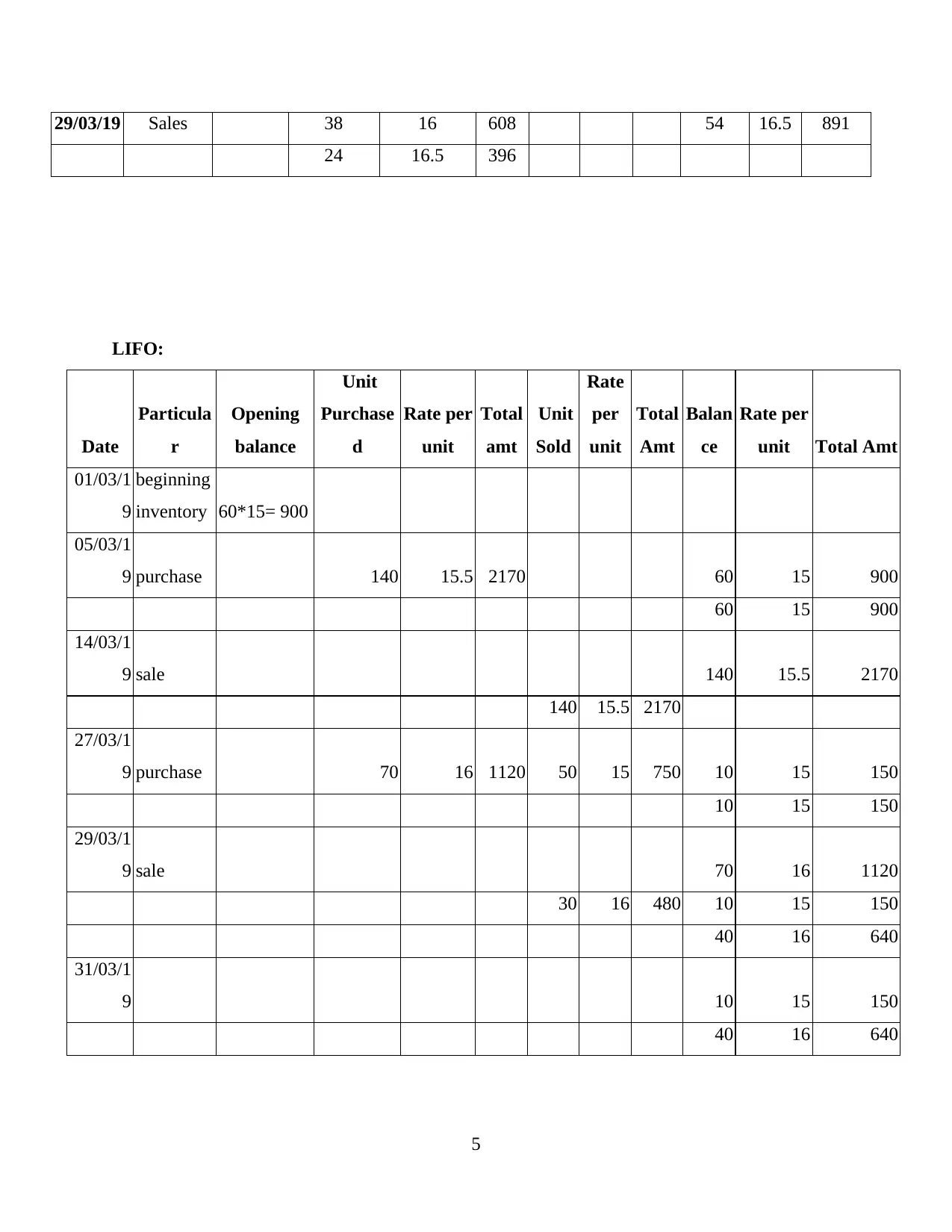
29/03/19 Sales 38 16 608 54 16.5 891
24 16.5 396
LIFO:
Date
Particula
r
Opening
balance
Unit
Purchase
d
Rate per
unit
Total
amt
Unit
Sold
Rate
per
unit
Total
Amt
Balan
ce
Rate per
unit Total Amt
01/03/1
9
beginning
inventory 60*15= 900
05/03/1
9 purchase 140 15.5 2170 60 15 900
60 15 900
14/03/1
9 sale 140 15.5 2170
140 15.5 2170
27/03/1
9 purchase 70 16 1120 50 15 750 10 15 150
10 15 150
29/03/1
9 sale 70 16 1120
30 16 480 10 15 150
40 16 640
31/03/1
9 10 15 150
40 16 640
5
24 16.5 396
LIFO:
Date
Particula
r
Opening
balance
Unit
Purchase
d
Rate per
unit
Total
amt
Unit
Sold
Rate
per
unit
Total
Amt
Balan
ce
Rate per
unit Total Amt
01/03/1
9
beginning
inventory 60*15= 900
05/03/1
9 purchase 140 15.5 2170 60 15 900
60 15 900
14/03/1
9 sale 140 15.5 2170
140 15.5 2170
27/03/1
9 purchase 70 16 1120 50 15 750 10 15 150
10 15 150
29/03/1
9 sale 70 16 1120
30 16 480 10 15 150
40 16 640
31/03/1
9 10 15 150
40 16 640
5
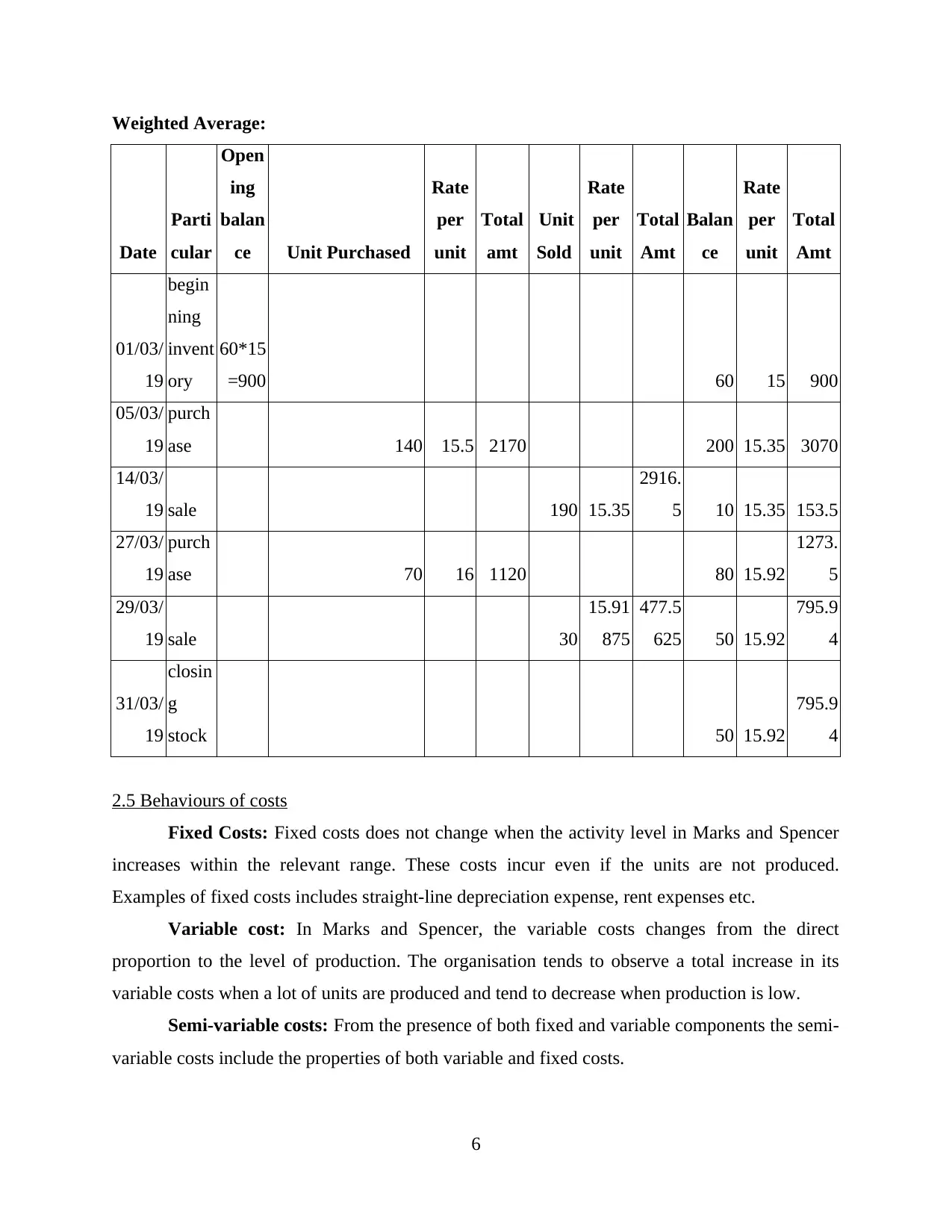
Weighted Average:
Date
Parti
cular
Open
ing
balan
ce Unit Purchased
Rate
per
unit
Total
amt
Unit
Sold
Rate
per
unit
Total
Amt
Balan
ce
Rate
per
unit
Total
Amt
01/03/
19
begin
ning
invent
ory
60*15
=900 60 15 900
05/03/
19
purch
ase 140 15.5 2170 200 15.35 3070
14/03/
19 sale 190 15.35
2916.
5 10 15.35 153.5
27/03/
19
purch
ase 70 16 1120 80 15.92
1273.
5
29/03/
19 sale 30
15.91
875
477.5
625 50 15.92
795.9
4
31/03/
19
closin
g
stock 50 15.92
795.9
4
2.5 Behaviours of costs
Fixed Costs: Fixed costs does not change when the activity level in Marks and Spencer
increases within the relevant range. These costs incur even if the units are not produced.
Examples of fixed costs includes straight-line depreciation expense, rent expenses etc.
Variable cost: In Marks and Spencer, the variable costs changes from the direct
proportion to the level of production. The organisation tends to observe a total increase in its
variable costs when a lot of units are produced and tend to decrease when production is low.
Semi-variable costs: From the presence of both fixed and variable components the semi-
variable costs include the properties of both variable and fixed costs.
6
Date
Parti
cular
Open
ing
balan
ce Unit Purchased
Rate
per
unit
Total
amt
Unit
Sold
Rate
per
unit
Total
Amt
Balan
ce
Rate
per
unit
Total
Amt
01/03/
19
begin
ning
invent
ory
60*15
=900 60 15 900
05/03/
19
purch
ase 140 15.5 2170 200 15.35 3070
14/03/
19 sale 190 15.35
2916.
5 10 15.35 153.5
27/03/
19
purch
ase 70 16 1120 80 15.92
1273.
5
29/03/
19 sale 30
15.91
875
477.5
625 50 15.92
795.9
4
31/03/
19
closin
g
stock 50 15.92
795.9
4
2.5 Behaviours of costs
Fixed Costs: Fixed costs does not change when the activity level in Marks and Spencer
increases within the relevant range. These costs incur even if the units are not produced.
Examples of fixed costs includes straight-line depreciation expense, rent expenses etc.
Variable cost: In Marks and Spencer, the variable costs changes from the direct
proportion to the level of production. The organisation tends to observe a total increase in its
variable costs when a lot of units are produced and tend to decrease when production is low.
Semi-variable costs: From the presence of both fixed and variable components the semi-
variable costs include the properties of both variable and fixed costs.
6
⊘ This is a preview!⊘
Do you want full access?
Subscribe today to unlock all pages.

Trusted by 1+ million students worldwide
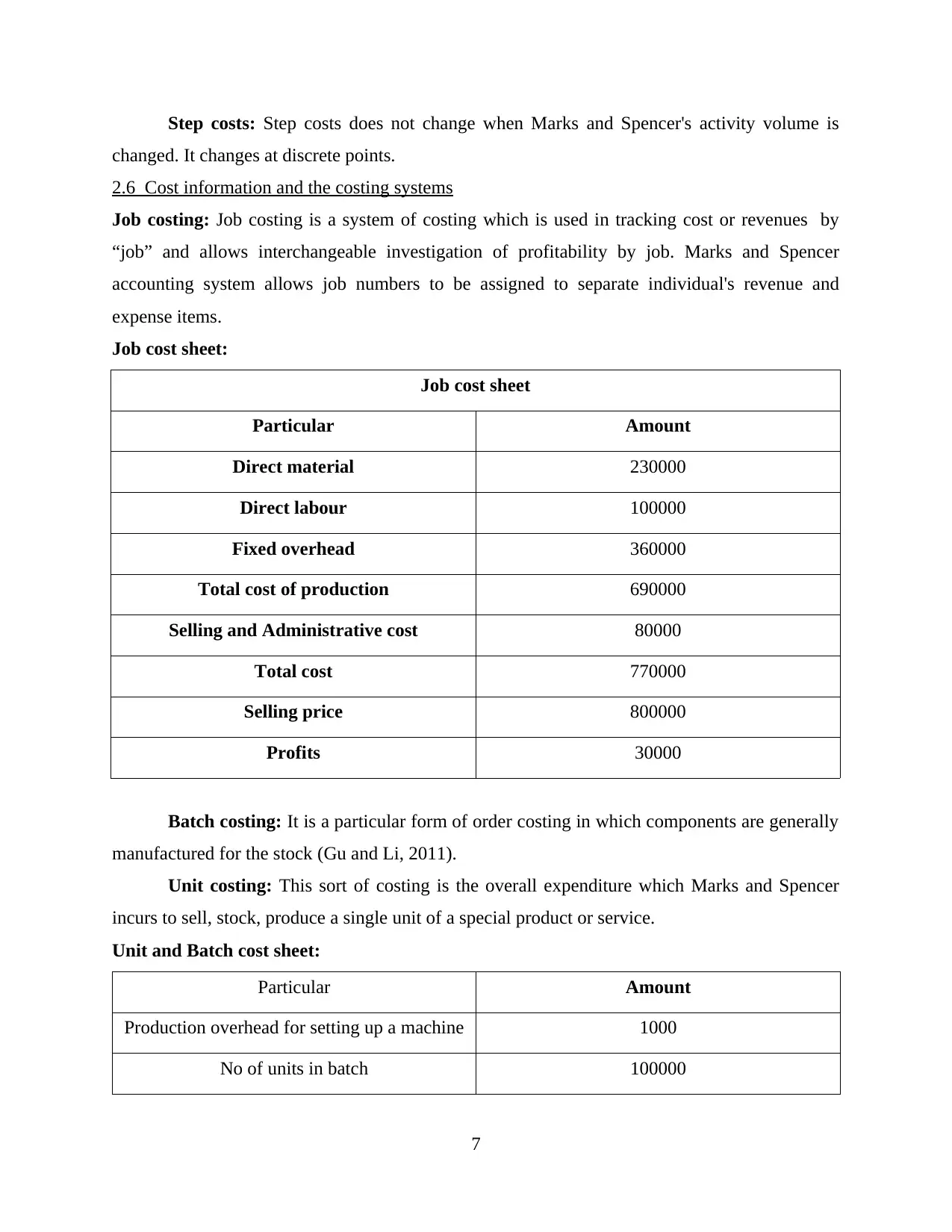
Step costs: Step costs does not change when Marks and Spencer's activity volume is
changed. It changes at discrete points.
2.6 Cost information and the costing systems
Job costing: Job costing is a system of costing which is used in tracking cost or revenues by
“job” and allows interchangeable investigation of profitability by job. Marks and Spencer
accounting system allows job numbers to be assigned to separate individual's revenue and
expense items.
Job cost sheet:
Job cost sheet
Particular Amount
Direct material 230000
Direct labour 100000
Fixed overhead 360000
Total cost of production 690000
Selling and Administrative cost 80000
Total cost 770000
Selling price 800000
Profits 30000
Batch costing: It is a particular form of order costing in which components are generally
manufactured for the stock (Gu and Li, 2011).
Unit costing: This sort of costing is the overall expenditure which Marks and Spencer
incurs to sell, stock, produce a single unit of a special product or service.
Unit and Batch cost sheet:
Particular Amount
Production overhead for setting up a machine 1000
No of units in batch 100000
7
changed. It changes at discrete points.
2.6 Cost information and the costing systems
Job costing: Job costing is a system of costing which is used in tracking cost or revenues by
“job” and allows interchangeable investigation of profitability by job. Marks and Spencer
accounting system allows job numbers to be assigned to separate individual's revenue and
expense items.
Job cost sheet:
Job cost sheet
Particular Amount
Direct material 230000
Direct labour 100000
Fixed overhead 360000
Total cost of production 690000
Selling and Administrative cost 80000
Total cost 770000
Selling price 800000
Profits 30000
Batch costing: It is a particular form of order costing in which components are generally
manufactured for the stock (Gu and Li, 2011).
Unit costing: This sort of costing is the overall expenditure which Marks and Spencer
incurs to sell, stock, produce a single unit of a special product or service.
Unit and Batch cost sheet:
Particular Amount
Production overhead for setting up a machine 1000
No of units in batch 100000
7
Paraphrase This Document
Need a fresh take? Get an instant paraphrase of this document with our AI Paraphraser
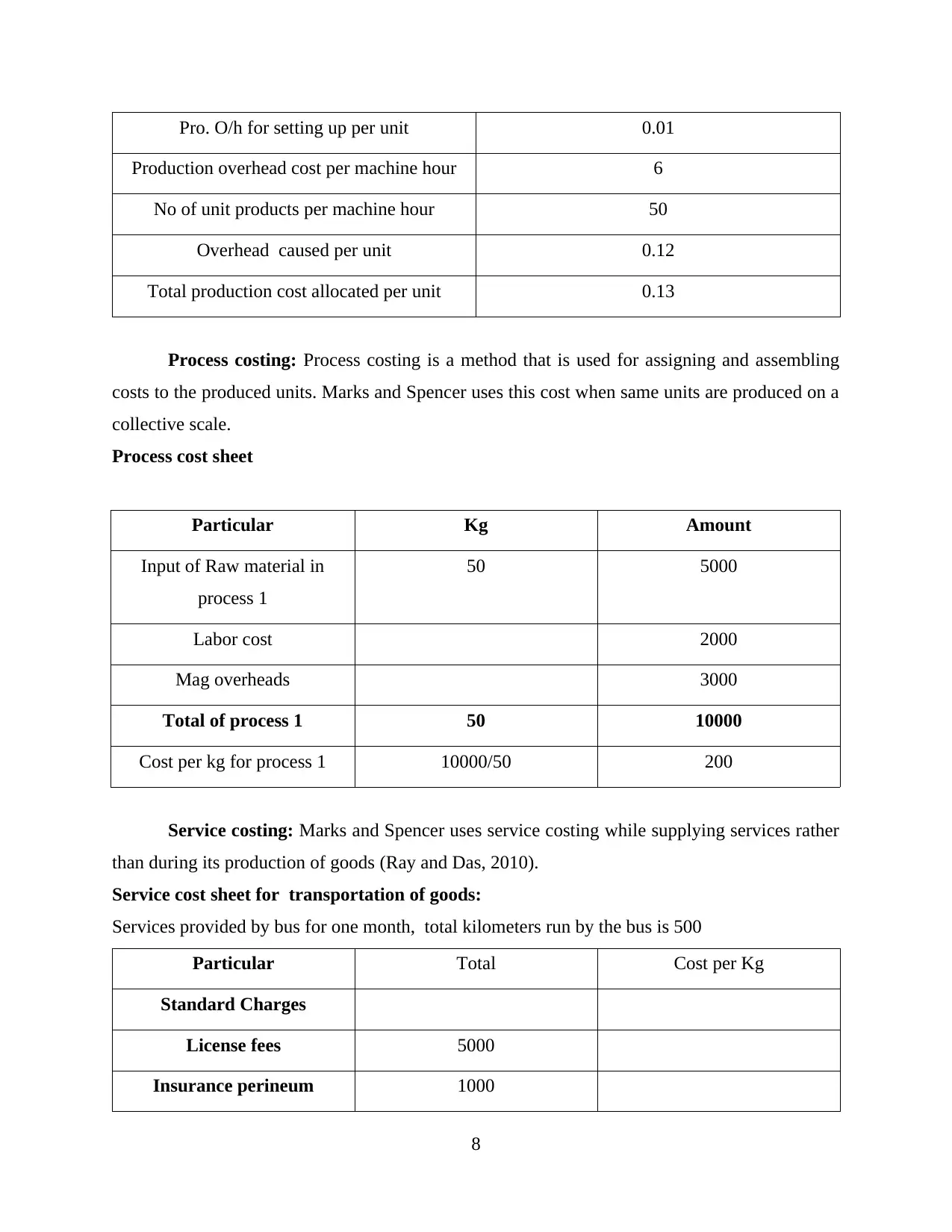
Pro. O/h for setting up per unit 0.01
Production overhead cost per machine hour 6
No of unit products per machine hour 50
Overhead caused per unit 0.12
Total production cost allocated per unit 0.13
Process costing: Process costing is a method that is used for assigning and assembling
costs to the produced units. Marks and Spencer uses this cost when same units are produced on a
collective scale.
Process cost sheet
Particular Kg Amount
Input of Raw material in
process 1
50 5000
Labor cost 2000
Mag overheads 3000
Total of process 1 50 10000
Cost per kg for process 1 10000/50 200
Service costing: Marks and Spencer uses service costing while supplying services rather
than during its production of goods (Ray and Das, 2010).
Service cost sheet for transportation of goods:
Services provided by bus for one month, total kilometers run by the bus is 500
Particular Total Cost per Kg
Standard Charges
License fees 5000
Insurance perineum 1000
8
Production overhead cost per machine hour 6
No of unit products per machine hour 50
Overhead caused per unit 0.12
Total production cost allocated per unit 0.13
Process costing: Process costing is a method that is used for assigning and assembling
costs to the produced units. Marks and Spencer uses this cost when same units are produced on a
collective scale.
Process cost sheet
Particular Kg Amount
Input of Raw material in
process 1
50 5000
Labor cost 2000
Mag overheads 3000
Total of process 1 50 10000
Cost per kg for process 1 10000/50 200
Service costing: Marks and Spencer uses service costing while supplying services rather
than during its production of goods (Ray and Das, 2010).
Service cost sheet for transportation of goods:
Services provided by bus for one month, total kilometers run by the bus is 500
Particular Total Cost per Kg
Standard Charges
License fees 5000
Insurance perineum 1000
8
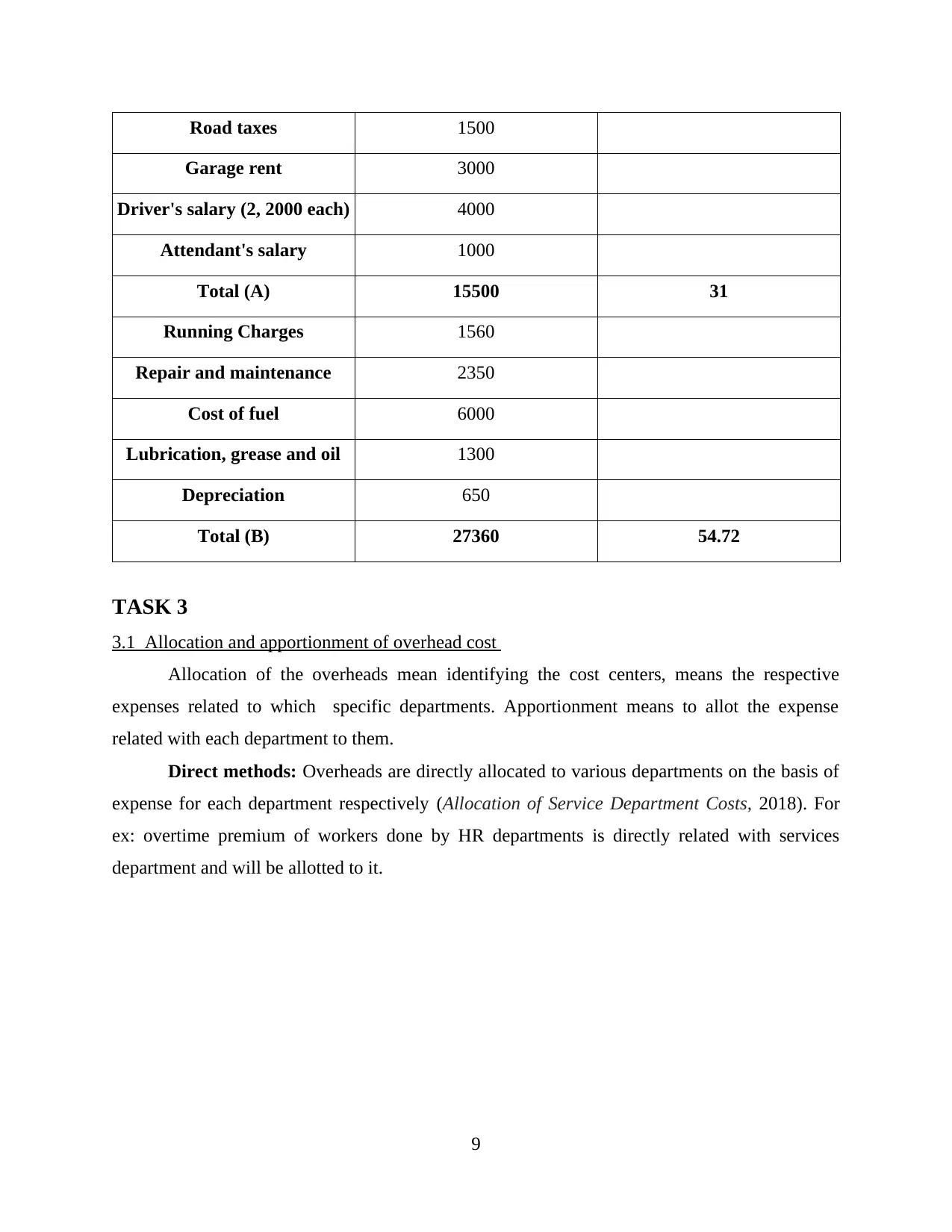
Road taxes 1500
Garage rent 3000
Driver's salary (2, 2000 each) 4000
Attendant's salary 1000
Total (A) 15500 31
Running Charges 1560
Repair and maintenance 2350
Cost of fuel 6000
Lubrication, grease and oil 1300
Depreciation 650
Total (B) 27360 54.72
TASK 3
3.1 Allocation and apportionment of overhead cost
Allocation of the overheads mean identifying the cost centers, means the respective
expenses related to which specific departments. Apportionment means to allot the expense
related with each department to them.
Direct methods: Overheads are directly allocated to various departments on the basis of
expense for each department respectively (Allocation of Service Department Costs, 2018). For
ex: overtime premium of workers done by HR departments is directly related with services
department and will be allotted to it.
9
Garage rent 3000
Driver's salary (2, 2000 each) 4000
Attendant's salary 1000
Total (A) 15500 31
Running Charges 1560
Repair and maintenance 2350
Cost of fuel 6000
Lubrication, grease and oil 1300
Depreciation 650
Total (B) 27360 54.72
TASK 3
3.1 Allocation and apportionment of overhead cost
Allocation of the overheads mean identifying the cost centers, means the respective
expenses related to which specific departments. Apportionment means to allot the expense
related with each department to them.
Direct methods: Overheads are directly allocated to various departments on the basis of
expense for each department respectively (Allocation of Service Department Costs, 2018). For
ex: overtime premium of workers done by HR departments is directly related with services
department and will be allotted to it.
9
⊘ This is a preview!⊘
Do you want full access?
Subscribe today to unlock all pages.

Trusted by 1+ million students worldwide
1 out of 20
Related Documents
Your All-in-One AI-Powered Toolkit for Academic Success.
+13062052269
info@desklib.com
Available 24*7 on WhatsApp / Email
![[object Object]](/_next/static/media/star-bottom.7253800d.svg)
Unlock your academic potential
Copyright © 2020–2025 A2Z Services. All Rights Reserved. Developed and managed by ZUCOL.





